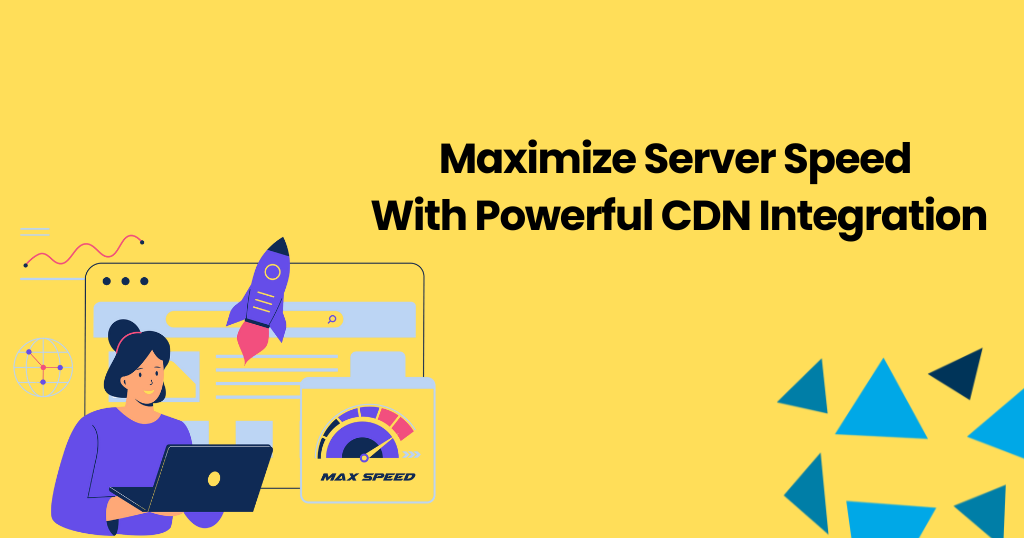Table of Contents
Hosting speed optimization is one of the most critical aspects of building a high-performing website. Among the key factors influencing your site’s loading speed is the initial server response time—the time it takes for your server to respond to a user request.
This metric directly impacts both user experience (UX) and SEO performance. A slow server response can delay page loads, frustrate visitors, and harm your search engine rankings. That’s why optimizing your hosting speed is essential to keeping your website fast, reliable, and competitive.
In this article, we’ll explore server response time, why it matters, and how to reduce it using proven hosting speed optimization techniques. You’ll also discover how CDN integration can drastically improve your website’s global delivery and reduce latency. From site speed audits to Core Web Vitals, we’ll guide you step by step to improve your web performance and make your website faster, more reliable, and user-friendly
What is the server response time?

Server response time is the duration it takes for a web server to respond after receiving an HTTP request from a user’s device. This is commonly known as Time to First Byte (TTFB), a key performance metric that measures how fast the first byte of data is delivered to the browser. While it’s typically measured in milliseconds, this small delay can have a big impact. A high TTFB means the browser waits longer before it even starts loading the page. This can result in visible issues like blank pages, broken layouts, or delayed content rendering, especially on interactive or real-time web applications.
Several factors can affect server response time, including
- Hosting quality and server resources
- Traffic load and concurrent users
- Unoptimized database queries
- Heavy or bloated backend code
- The geographical distance between the server and the user
➡️There are recommendations from Google about how to improve server response time
Why Hosting Speed Matters for SEO & UX

Your website’s speed directly impacts both search engine optimization (SEO) and user experience (UX), two critical factors that determine your site’s success.
1. Site Speed and SEO
As we’ve discussed earlier in the “Web Hosting & SEO: 8 Key Factors That Drive Search Success” blog, your web hosting plays a critical role in SEO. Search engines like Google prioritize fast-loading websites to provide users with quick and relevant results. A poor hosting environment with slow servers can directly harm your site’s performance in search results.
Google’s algorithm now includes Core Web Vitals as part of its ranking criteria:
- Largest Contentful Paint (LCP) Measures how fast your main content loads (it should be under 2.5 seconds).
- First Input Delay (FID): Measures how quickly a page responds to user actions (lower is better).
- Cumulative Layout Shift (CLS): Ensures the page doesn’t shift unexpectedly while loading.
- A sluggish server response time can harm these metrics, leading to:
❌ Lower search rankings
❌ Fewer pages being crawled (hurting new content visibility)
❌ Lost opportunities in mobile-first indexing
2- Page Loading Speed and UX
From a user’s perspective, speed is everything. Modern users expect websites to load in 2–3 seconds, and mobile users are even less forgiving. A slow-loading page creates friction, which translates to:
- With higher bounce rates, users abandon slow pages within seconds.
- Reduced conversions, a 1-second delay can reduce conversions by 7% as case studies have shown
- Lower engagement users interact less with sluggish pages, reducing time on site and overall satisfaction.
Fast websites, on the other hand, feel professional and trustworthy and keep visitors engaged longer.
The power of CDN Integration

A content delivery network (CDN) is a globally distributed network of servers designed to deliver web content quickly, reliably, and securely. Instead of relying on a single server to handle all traffic, a CDN caches your website’s static assets, like images, CSS, and JavaScript, on servers (or “edge nodes”) strategically placed around the world.
When a user visits your site, the CDN automatically serves content from the server closest to their location. This reduces the physical distance data needs to travel, leading to:
– Faster page load times; studies show CDNs can reduce global page load times by up to 44%
– Lower latency and improved performance during traffic spikes
– Enhanced reliability through server redundancy; if one server fails, another takes over seamlessly
– Better SEO and UX, as Google favors faster, more stable websites in search rankings
Think of a CDN like an ATM network: instead of making a long trip to a single bank, users get instant access to their money from the nearest machine. Similarly, CDNs bring your content closer to your users, wherever they are in the world.
Key Server Optimization Techniques
Improving your server’s performance is crucial to ensure your website remains fast, stable, and capable of handling high traffic. A slow or under-optimized server directly impacts TTFB, which can harm both user experience and search engine rankings.
Here are essential techniques to optimize server response time:
1. Optimize Your Application Logic
Inefficient application code can slow down server processing. Refactor heavy scripts and eliminate unnecessary database calls to reduce processing delays.
2. Use Efficient Database Queries
Slow database performance is a common bottleneck. Implement indexing, caching, and query optimization to improve response time.
3. Enable Caching
Caching means storing a “ready-made” version of your website’s data so the server doesn’t have to process everything from scratch every time. This helps your site respond faster and reduces load times for visitors.
4. Use Load Balancing
Load balancing helps share traffic between multiple servers so no single server gets too busy. This keeps your website running smoothly, even when lots of people visit at the same time.
5. Upgrade Hosting Infrastructure
As your business grows and your website attracts more traffic, your current hosting plan might no longer be enough to handle the load. Shared hosting, for example, means your site shares resources (like CPU, RAM, and bandwidth) with many other websites. This can cause slowdowns, especially during traffic spikes. Upgrading to a more powerful hosting solution ensures your website stays fast, stable, and ready for growth.
If you decide to upgrade your plan, Thamara can help you choose the right hosting plan to keep your site fast, stable, and ready for growth.
6. Monitor and Analyze Performance Regularly
Use tools like PageSpeed Insights to monitor server metrics and identify potential issues before they affect users.
Measuring & Monitoring Your Website’s Speed?
You can’t improve what you don’t measure. Monitoring your website’s speed helps you understand how it performs for real users and where bottlenecks are slowing it down.
Why monitor speed?
Slow websites frustrate visitors and hurt your SEO rankings. Regular speed checks let you:
- Spot performance issues early.
- Track improvements after optimization.
- Ensure your site stays fast during traffic spikes.
Key tools to measure website speed:
- Google PageSpeed Insights analyzes load times and provides suggestions to improve Core Web Vitals.
- GTmetrix: See a detailed breakdown of speed metrics and bottlenecks.
- Pingdom monitors uptime and page performance globally.
Conclusion:
Your website’s speed isn’t just a technical detail; it’s the key to keeping users happy and improving your SEO. By optimizing server response time and using a CDN, you can deliver faster load times, reduce bounce rates, and grow your online success so Want to make your website faster and more reliable? Explore performance hosting with Thamara, integrate smart optimizations, and keep your site performing at its best.



